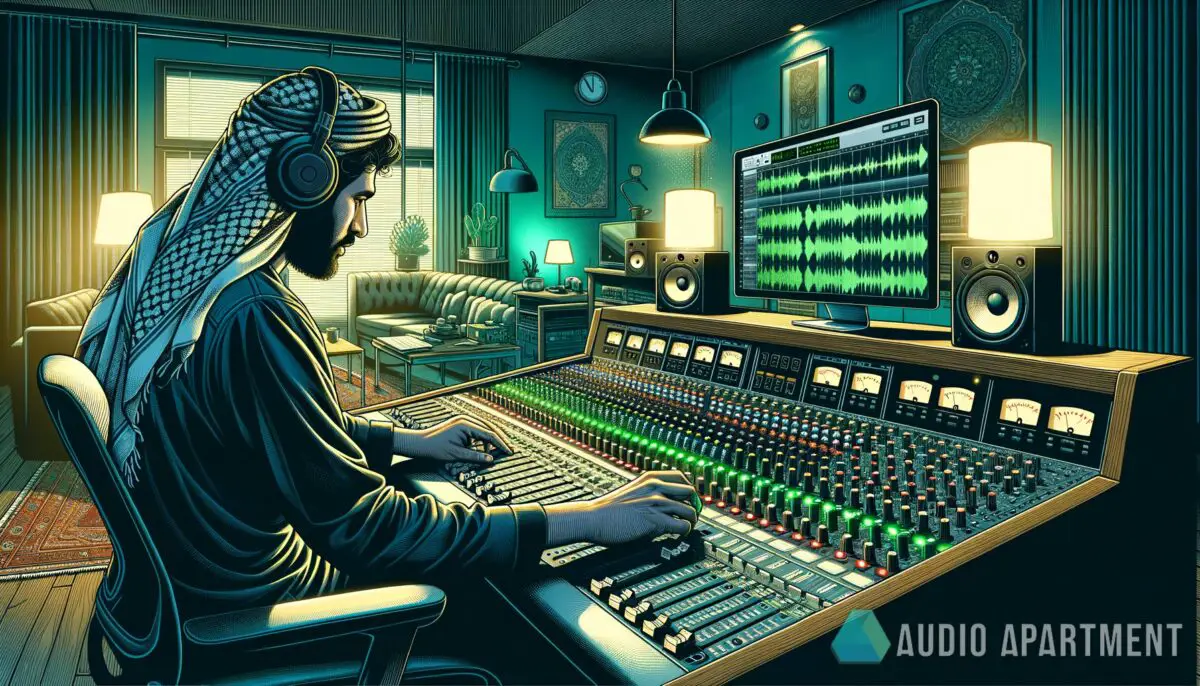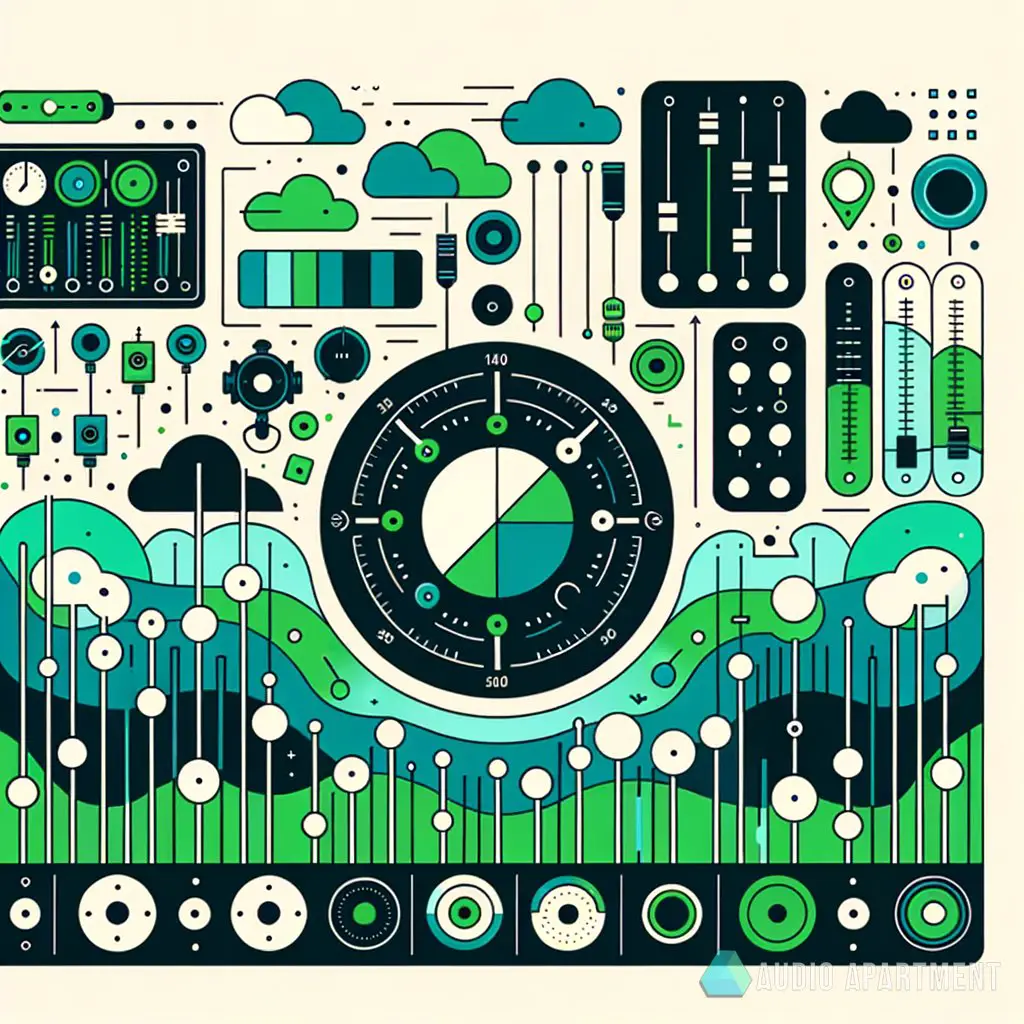Picture this: You’ve just wrapped up the mix on your latest track in your home studio, and it’s sounding as tight as the perfect pair of headphones you picked from my curated selection of studio headphones. But then you add reverb, and suddenly it’s like you’ve stepped into a whole new realm.
Why does reverb transform your mix? In this post, we dive into the magic of spatial depth and how it can make or break your sound.
Key takeaways
- Reverb creates the illusion of space and provides context to sounds.
- Use EQ to clean up the reverb and avoid muddiness.
- Automate reverb to introduce dynamic changes to the mix.
- A common reverb bus can glue your mix together, enhancing cohesion.
How does reverb add spatial depth to mixes?
Reverb is like the secret seasoning that chefs won’t tell you about; it’s the difference between flat and full, between a recording that sounds like it’s happening inside your head versus one that unfolds in a three-dimensional space around you. At its core, reverb simulates the natural echo that would occur if the sound were being played in a physical environment.

It’s the way sound waves bounce off walls, ceilings, and objects, giving your ears a sense of depth and distance.
But it’s not just about slapping on any reverb; it’s about using reverb with intention. When applied correctly, reverb can provide context to your instruments, placing them in a “room” that adds to the story of the song.
It can create a sense of atmosphere, mood, and emotion that dry, unprocessed tracks lack. And from a mixer’s standpoint, reverb helps to gel disparate elements together, making a disparate multitrack recording sound like a cohesive unit, and giving your mix that sought-after studio polish.
“Reverb is like the secret seasoning that chefs won’t tell you about; it’s the difference between flat and full, between a recording that sounds like it’s happening inside your head versus one that unfolds in a three-dimensional space around you. It’s all about using reverb with intention to provide context, atmosphere, and emotion.”
Here’s a quick rundown on the perks of proper reverb use:
- It can create an illusion of space, turning a cramped mix into an expansive soundscape.
- Fine-tuned reverb settings can help distinguish each instrument’s position in the mix, from up close and personal to far and wide.
- A touch of reverb can add vibe and character to sterile sounds, making them breathe with energy.
With handy links to the best studio monitors and DAWs, you can experiment to find the reverb that resonates with your mix’s soul.
If you are a visual learner, check out this video titled ‘Creating 3D Space In A Mix | Depth, Width & Height’
AKAI Professional MPK Mini MK3

AKAI Professional MPK Mini MK3
Tailoring reverb to your mix
Understanding how reverb works is key to mastering its impact. Reverb is essentially a series of echos that create the perception of space around a sound.
Imagine clapping your hands in a cathedral versus in a closet; the size of the space is integral to the sound’s decay, and that’s what reverb in a mix emulates.
Space design through decay time and pre-delay provides control over how vast a room feels and how immediate a sound appears. By tweaking decay times, you create environments from intimate studios to grand concert halls.
Pre-delay, the gap before the reverb kicks in, can make your vocals stand out before they blend into the mix’s ambience.
Reverb types and texturesplay into the character of the space. Room and hall reverbs offer naturalistic settings, while plate and spring reverbs bring a specific color and vintage vibe.
Each type adds a unique flavor, and knowing when to use them can elevate your production.
Reverb coupling with frequency and equalization
Frequency adjustments are crucial when applying reverb. Not all frequencies interact with space in the same way.

Low-end rumbles can turn to mud when flooded with reverb, while highs can shimmer too brightly.
Balancing reverb with EQ is a nuanced process. Applying high-pass filters to reverb can prevent low-frequency build-up, ensuring clarity.
Conversely, rolling off the highs can subdue an overly bright reverb tail, making it sit better in the mix and compliment the main signals rather than competing with them.
Details about frequency-specific reverb and its importance are crucial for advanced production techniques. It’s about selecting the right reverb for the right track—bass parts might need tighter, darker reverbs, while vocals might benefit from airy, expansive treatments.
Dynamic reverb application
Reverb isn’t static; its behavior can change with the dynamics of the performance. Consider how whispering in a hallway differs from shouting; the space reacts uniquely to the volume of the sound.
Using compression before reverb ensures a consistent level before the signal hits the reverb, translating into a more stable sonic space. Plus, sidechain compression post-reverb allows important tracks to carve out space, diminishing reverb when the signal is present.
Creative application of gated reverb—cutting off the reverb tail abruptly—can yield rhythmic textures and a sense of tightness, especially useful in percussive elements of your mix.
The depth-placement effect of reverb
Where an instrument sits in the mix—front, middle, or back—can be influenced heavily by reverb. This aspect of depth-placement is part of what gives a mix its three-dimensional feel.
Reverb level is crucial here; more reverb can push an instrument further back in the perceived sound field, while less can bring it forward. Wet/Dry balance and your pan settings—determining the stereo position—intertwine to shape where an instrument “lives” in your mix.
Automation of reverb parameters over time allows for dynamic shifts in the soundstage. It can draw a listener’s focus or create movement within the track, portraying a sonic journey through varied spaces.

Gluing your mix with common reverb
Sometimes what a mix needs is cohesion, and a common, shared reverb can serve as the glue. It’s about creating a unifying ambiance that envelops all elements, suggesting they were performed together, in the same space.
Utilizing a reverb bus or send effect allows multiple tracks to access the same reverb setting. This lets you adjust the amount of reverb each element receives, blending them into one believable acoustic environment.
Strategically assigning the amount of send determines the placement of each instrument within the shared space, granting you the power to orchestrate depth and presence while maintaining unity in your mix.
Mixing with intention and reference tracks
For any mix engineer looking to nail the perfect reverb, context is everything. Using reference tracks for reverb comparison can offer valuable insights.
Check out why using reference tracks is essential in mixing for a deeper dive on the subject.
Start by identifying professional mixes that capture the space and depth you aim to achieve. Studying their reverb parameters gives you a target for your own spatial effects.
Being intentional means selecting reverb types and settings that align with your track’s emotional tone. A somber ballad might call for a different reverb than a high-energy pop song.
(The table for SECTION = “Data table” is omitted as the data needed for its creation is not provided in the input prompt.)
Navigating the world of reverb can be like walking through a hall of mirrors – it’s easy to get disoriented. To keep your mixes sounding sculpted and professional, it’s important to have a solid grasp of the dos and don’ts when it comes to adding spatial depth.
Here’s a breakdown to keep your reverb application on point.
| Do | Don’t |
|---|---|
| Use reverb to create the illusion of space | Overdo it with reverb, causing a mix to become muddy |
| Tailor reverb settings to suit the vibe of the track | Apply the same reverb indiscriminately to all tracks |
| Fine-tune pre-delay and decay for natural-sounding ambiance | Ignore timing settings that can result in an unnatural effect |
| Automate reverb sends for dynamic mixing | Forget to consider the dynamic range when applying reverb |
| Employ EQ to clean up the reverb signal | Allow reverb to clutter the low-end and overpower the mix |
| Utilize reverb buses for a cohesive sound across multiple tracks | Use too much reverb on elements meant to be upfront in the mix |
| Reference professional tracks to guide your reverb application | Neglect testing your mix on different systems for consistency |
Keep these pointers in hand, and you’ll enhance your mixes like a pro, using reverb to its full potential without stepping into common pitfalls.
Crafting depth with reverb is an art, and these guidelines will help maintain balance and clarity in your music.
In my opinion, while I’m no expert, the transformative power of reverb in music can’t be overstated. It’s astounding how adding a bit of reverb can take a sound from feeling isolated and bland to lush and expansive.
When I tinker with reverb settings in my home studio, it’s like painting with sound; I can place each instrument in its own unique space and create a mix that’s not just heard but felt.
And here’s the thing: you don’t need to be a pro to play around with these effects. There are tons of resources and gear, like the best DAWs for producers, that can guide your exploration.
Trust your ears, experiment, and remember, a small tweak can lead to a huge difference in the depth and vibe of your tracks.
Frequently asked questions (FAQ)
What’s the best way to determine the right reverb settings for my track?
Experimentation is key; start with presets that closely match the type of space you envision for your track. Then, adjust decay time, pre-delay, and wet/dry balance while considering the song’s tempo and rhythmic elements.
To hone in on the perfect setting, regularly A/B test with the dry signal and reference tracks with a similar sound.
How do I use reverb on bass-heavy tracks without causing muddiness?
For bass-heavy tracks, keep reverb minimal and focus on high-pass filtering the effect to reduce low-end clutter. Focus on the mid to high frequencies when applying reverb and make sure to EQ post-reverb.
This approach prevents muddiness and retains clarity in the low end.
Can reverb be used effectively in electronic music, which is usually synth-based?
Absolutely. In electronic music, reverb is essential to give synthetic sounds a sense of place and realism.
Tailored reverb enhances dance tracks by adding movement and depth, especially on percussive elements and atmospheric pads. Just be mindful of the reverb’s timing and tone so it complements the electronic palette without overwhelming it.
Final thoughts
Embarking on the journey of reverb application can be as thrilling as it is challenging. Through creative exploration and technical understanding, you can inject life and dimension into your mixes, making them not just sound better but feel complete.
Remember, reverb is a powerful tool, but it requires a delicate touch—stay intentional, and use it to support your track’s story and emotional pull. With practice and patience, the art of perfect reverb will no longer be a mystery, but a trusted ally in your production arsenal.
What’s your go-to reverb trick that adds magic to your mixes? Did I cover everything you wanted to know? Let me know in the comments section below – I read and reply to every comment. If you found this article helpful, share it with a friend, and check out my full blog for more tips and tricks on mastering reverb.
Thanks for reading, and keep those mixes sounding deep and divine!















